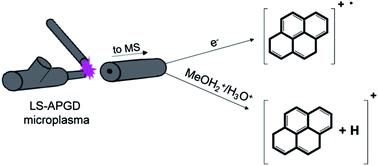当前位置:
X-MOL 学术
›
J. Anal. At. Spectrom.
›
论文详情
Our official English website, www.x-mol.net, welcomes your
feedback! (Note: you will need to create a separate account there.)
Mass spectrometric characteristics and preliminary figures of merit for polyaromatic hydrocarbons via the liquid sampling-atmospheric pressure glow discharge microplasma
Journal of Analytical Atomic Spectrometry ( IF 3.1 ) Pub Date : 2020-09-23 , DOI: 10.1039/d0ja00373e Tyler J. Williams 1, 2, 3, 4 , Jacob R. Bills 1, 2, 3, 4 , R. Kenneth Marcus 1, 2, 3, 4
Journal of Analytical Atomic Spectrometry ( IF 3.1 ) Pub Date : 2020-09-23 , DOI: 10.1039/d0ja00373e Tyler J. Williams 1, 2, 3, 4 , Jacob R. Bills 1, 2, 3, 4 , R. Kenneth Marcus 1, 2, 3, 4
Affiliation

|
The liquid sampling-atmospheric pressure glow discharge (LS-APGD) has been demonstrated as a combined atomic and molecular (CAM) ionization source, through the analysis of elemental species, small polar molecules, and proteins. Operation using 2% HNO3 as the electrolytic carrier solution is employed for elemental analysis, while simply changing to a MeOH : H2O solution results in mass spectra reflecting the protonation of polar molecular species. In an effort to expand the already diverse sampling capabilities of the LS-APGD, the determination of low-polarity polyaromatic hydrocarbons (PAHs) was investigated. These molecules contain none of the common polar sites for protonation, typically undergoing ionization via charge transfer or electron ionization, forming radical cations. While LS-APGD ionization is believed to involve both electron and Penning ionization, as well as solvent-derived gas phase proton transfer reactions, it was expected that a radical cation formation would be the sole product for PAHs. Interestingly, both radical cation and protonated molecular ions were observed for each of the PAHs studied, suggesting concurrent electron/Penning ionization and atmospheric pressure chemical ionization (APCI). In order to assess the potential analytical utility of the approach, preliminary detection limits of as low as 270 pg mL−1 (5.4 pg, absolute) have been realized. The addition of PAH species to the microplasma's analyte portfolio expands the concept of CAM ionization, finding utility in diverse fields, including environmental analysis and petroleomics.
中文翻译:

液体采样-大气压辉光放电微等离子体对多环芳烃的质谱特征和初步评价
通过分析元素种类,小极性分子和蛋白质,已证明液体采样-大气压辉光放电(LS-APGD)作为原子和分子(CAM)的组合电离源。使用2%HNO 3作为电解载体溶液的操作用于元素分析,而简单地更改为MeOH:H 2 O溶液则会得到反映极性分子物质质子化的质谱。为了扩大LS-APGD业已多样化的采样能力,研究了低极性聚芳烃(PAHs)的测定。这些分子不包含质子化的通常极性位,通常通过电荷转移或电子电离,形成自由基阳离子。尽管据信LS-APGD电离既涉及电子电离,也涉及潘宁电离,还包括溶剂衍生的气相质子转移反应,但人们预计自由基阳离子的形成将是PAHs的唯一产物。有趣的是,对于每个研究的PAHs,都观察到自由基阳离子和质子化分子离子,表明同时发生电子/笔离子电离和大气压化学电离(APCI)。为了评估该方法的潜在分析实用性,初步检测限低至270 pg mL -1(5.4 pg,绝对值)已经实现。将PAH物种添加到微等离子体的分析物产品组合中,扩展了CAM电离的概念,在环境分析和石油化学等多个领域找到了实用性。
更新日期:2020-11-03
中文翻译:

液体采样-大气压辉光放电微等离子体对多环芳烃的质谱特征和初步评价
通过分析元素种类,小极性分子和蛋白质,已证明液体采样-大气压辉光放电(LS-APGD)作为原子和分子(CAM)的组合电离源。使用2%HNO 3作为电解载体溶液的操作用于元素分析,而简单地更改为MeOH:H 2 O溶液则会得到反映极性分子物质质子化的质谱。为了扩大LS-APGD业已多样化的采样能力,研究了低极性聚芳烃(PAHs)的测定。这些分子不包含质子化的通常极性位,通常通过电荷转移或电子电离,形成自由基阳离子。尽管据信LS-APGD电离既涉及电子电离,也涉及潘宁电离,还包括溶剂衍生的气相质子转移反应,但人们预计自由基阳离子的形成将是PAHs的唯一产物。有趣的是,对于每个研究的PAHs,都观察到自由基阳离子和质子化分子离子,表明同时发生电子/笔离子电离和大气压化学电离(APCI)。为了评估该方法的潜在分析实用性,初步检测限低至270 pg mL -1(5.4 pg,绝对值)已经实现。将PAH物种添加到微等离子体的分析物产品组合中,扩展了CAM电离的概念,在环境分析和石油化学等多个领域找到了实用性。











































 京公网安备 11010802027423号
京公网安备 11010802027423号